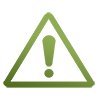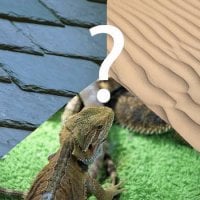Enclosures What is the Ideal Humidity for a Bearded Dragon, and How Do I Maintain It?
- By Shinryu
Always measure humidity in your beardie's enclosure using a digital probe hygrometer. Please do not rely on analog hygrometers since they tend to be inaccurate. When you measure humidity, please place the probe on the back center wall of the tank.
Generally, bearded dragons suffer many more health problems from high humidity than from low humidity levels. For instance, high humidity levels can lead to fungal infections, such as the dreaded yellow fungus, and bacterial infections, such as upper respiratory infections (URIs).
Humidity levels that regularly approach 70% or higher (especially if you're seeing condensation on the glass) can contribute to unsanitary conditions in your bearded dragon's enclosure, leading to the proliferation of fungal and bacterial organisms that can harm your beardie.
Please keep in mind that if you measure humidity closer to the basking side of the enclosure, you will likely get humidity levels much lower than the average for your beardie's tank since the hot side of the enclosure is baked by the basking lamp during the day. Likewise, measuring the cool side will result in higher readings.
So what is the best way to control and maintain humidity levels in your beardie's habitat? Taking measurements with a digital hygrometer is an essential first step.
Another vital thing to remember is that only screen tops provide the proper ventilation for a bearded dragon enclosure. Adequate ventilation is essential for regulating humidity levels. Glass lids would increase humidity to unacceptable levels for bearded dragons.
Maintaining proper temperatures on the hot and cool sides of the enclosure can also help regulate humidity levels.
For most homes, a room humidifier to increase the humidity in your beardie's tank is unnecessary. However, if you choose to use a room humidifier, please make sure that the humidifier automatically stops after reaching the desired humidity level. It is also essential to never mist your bearded dragon or the enclosure since they are not tropical species and will suffer various health problems from this practice. While many bearded dragons won't drink from a water dish, some owners choose to have a water dish in the enclosure to increase humidity levels.
Inversely, if you're trying to decrease humidity levels, ensure the room is well-ventilated, use a small dehumidifier if needed, and remove the water dish from the beardie's enclosure. If you are uncomfortable with completely removing the water dish, place it on the cool side of the enclosure to reduce evaporation. A rice sock placed inside the tank can also help lower humidity. Avoid using water features such as bubblers. If your enclosure contains live plants, put them on the cool side.
Please keep in mind that it is normal for humidity levels to fluctuate. In many cases, you may not need to do anything to increase or decrease the humidity inside your beardie's tank. It is far more essential to ensure that your general husbandry practices are sound than to monitor and control relative humidity levels compulsively. Healthy bearded dragons not stressed by their environment are more likely to manage normal humidity-level fluctuations without adverse health effects.
Humidity levels that regularly approach 70% or higher (especially if you're seeing condensation on the glass) can contribute to unsanitary conditions in your bearded dragon's enclosure, leading to the proliferation of fungal and bacterial organisms that can harm your beardie.
Please keep in mind that if you measure humidity closer to the basking side of the enclosure, you will likely get humidity levels much lower than the average for your beardie's tank since the hot side of the enclosure is baked by the basking lamp during the day. Likewise, measuring the cool side will result in higher readings.
So what is the best way to control and maintain humidity levels in your beardie's habitat? Taking measurements with a digital hygrometer is an essential first step.
Another vital thing to remember is that only screen tops provide the proper ventilation for a bearded dragon enclosure. Adequate ventilation is essential for regulating humidity levels. Glass lids would increase humidity to unacceptable levels for bearded dragons.
Maintaining proper temperatures on the hot and cool sides of the enclosure can also help regulate humidity levels.
For most homes, a room humidifier to increase the humidity in your beardie's tank is unnecessary. However, if you choose to use a room humidifier, please make sure that the humidifier automatically stops after reaching the desired humidity level. It is also essential to never mist your bearded dragon or the enclosure since they are not tropical species and will suffer various health problems from this practice. While many bearded dragons won't drink from a water dish, some owners choose to have a water dish in the enclosure to increase humidity levels.
Inversely, if you're trying to decrease humidity levels, ensure the room is well-ventilated, use a small dehumidifier if needed, and remove the water dish from the beardie's enclosure. If you are uncomfortable with completely removing the water dish, place it on the cool side of the enclosure to reduce evaporation. A rice sock placed inside the tank can also help lower humidity. Avoid using water features such as bubblers. If your enclosure contains live plants, put them on the cool side.
Please keep in mind that it is normal for humidity levels to fluctuate. In many cases, you may not need to do anything to increase or decrease the humidity inside your beardie's tank. It is far more essential to ensure that your general husbandry practices are sound than to monitor and control relative humidity levels compulsively. Healthy bearded dragons not stressed by their environment are more likely to manage normal humidity-level fluctuations without adverse health effects.
Display on Homepage :
- Enabled
Last edited:




